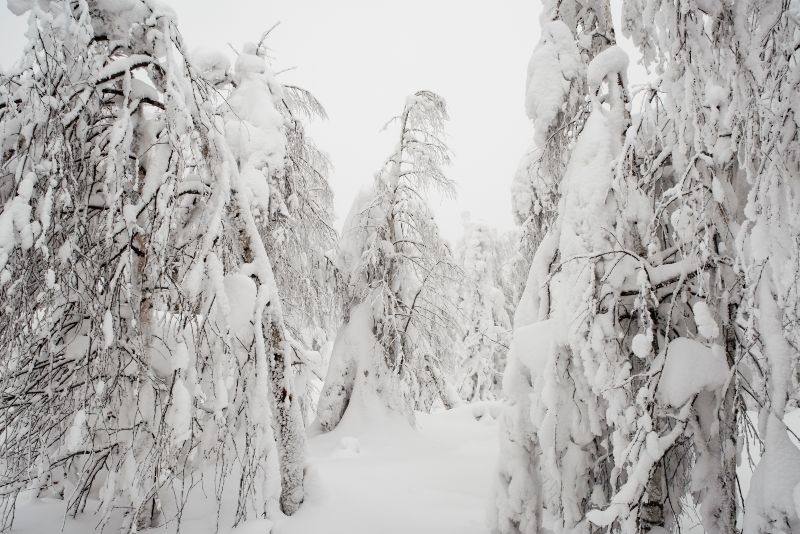
Winter storms can transform the world into a sparkling wonderland, but the frozen facade conceals potential dangers lurking underneath. While we may marvel at the enchanting sight of ice-covered trees, it’s crucial to acknowledge the hazards that accompany it. In this blog, we’ll explore the potential peril of ice-covered trees and provide essential tips on safeguarding both your trees and yourself during the frosty days of winter.
Why Ice-Covered Trees Are Dangerous?
The picturesque scene of ice-laden branches can mask the potential dangers that accompany such wintry beauty. The added weight of ice can lead to branches breaking and falling, creating hazards for anything beneath. Falling ice and snow pose risks to pedestrians, property, and vehicles, increasing the need for caution during icy conditions. Additionally, the impact of damaged branches on power lines can result in power outages and disruptions in utility services, creating widespread electrical failures. The potential for such damages necessitates proactive measures to mitigate these risks and ensure people’s and property’s safety.
What Can You Do When Your Trees Are Ice-Covered?
-
Check Trees Safely:
Before approaching any icy or snow-laden trees, ensure safety by assessing them from a distance. Be cautious of potential hazards, such as hanging or broken branches, and refrain from standing directly under limbs weighed down by ice or snow.
-
Utility Awareness:
If ice-covered trees pose a threat to or have damaged power lines, contact utility companies immediately. Prompt action can prevent power outages and ensure the safety of your community.
-
Give Trees Time to Recover:
Don’t rush to shed ice and snow off your trees after a winter storm. Allow trees time to shed the frozen precipitation naturally and recover, especially if warmer weather is forecasted. Avoid unnecessary interventions that may accidentally worsen the damage.
What Should You Not Do?
-
Avoid Shaking Branches:
Resist the temptation to shake branches to remove ice and snow. This seemingly innocent action can lead to unintentional breakage, causing more harm than good. Frozen branches are particularly brittle and may break when shaken. Branches are also more flexible than they appear, so they may bounce back and snap when the weight of ice and snow is suddenly shed all at once.
-
Say No to De-icing Salts:
Refrain from using de-icing salts around trees. While they help melt ice on walkways and roads, these salts can harm tree roots and compromise overall tree health.
-
No Spraying with Water:
Avoid spraying trees with water despite the desire to speed up the melting process. This method can worsen the situation, causing ice to refreeze, weighing down the branches even more, and creating additional risks.
Which Trees Are Most Vulnerable to Ice Damage?
Certain trees are more susceptible to ice damage, particularly those with heavy canopies or weakly attached branches. Species like birch, cottonwood, and willow naturally have weaker wood that snaps easily under heavy loads of ice and snow. Older, mature trees are also more prone to damage than younger trees. Identifying these vulnerable trees allows for targeted preventive measures and increased vigilance during winter storms.
How to Prevent Ice Damage to Trees?
-
Proper Pruning:
One effective way to reduce the risk of ice-related damage is to prune your trees before the winter storm arrives. By removing weak or dead branches, you decrease the likelihood of ice accumulation on vulnerable parts of the tree. Also, prune to avoid narrow branch attachment angles and ensure proper branch spacing. This reduces the risk of ice or snow buildup and minimizes potential damage. Regular pruning not only enhances the overall health of your trees but also makes them more resilient during the onset of winter weather.
-
Provide Structural Support:
For particularly valuable or large trees on your property, consider providing additional structural support. Install braces or cables to help distribute the weight of ice more evenly across the tree, reducing the strain on individual branches. Consulting with a professional arborist can help you determine the best course of action for safeguarding your trees.
As winter storms envelop our surroundings in icy splendor, remember to recognize the potential dangers that can accompany such beauty. In the case of sudden tree or branch failures, contact us for Emergency Tree Services to restore your property’s beauty and safety. But by understanding the risks posed by ice-covered trees and taking proactive steps, you can protect both your trees and your communities. Stay informed, stay prepared, and enjoy the beauty of winter safely!





